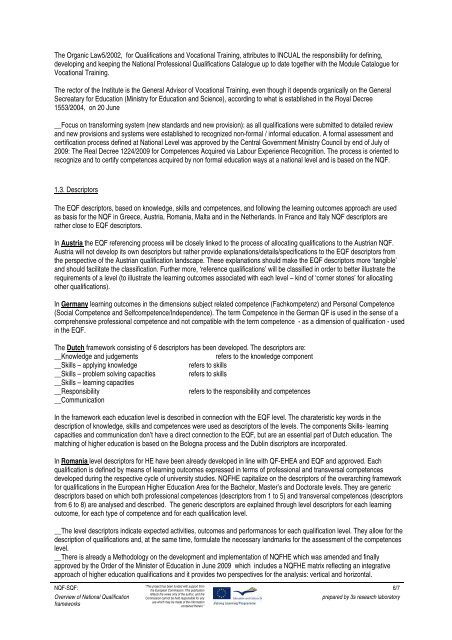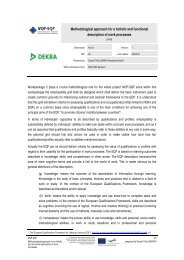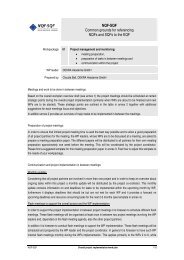Overview of National Qualification frameworks - Project-Nqf-Sqf
Overview of National Qualification frameworks - Project-Nqf-Sqf
Overview of National Qualification frameworks - Project-Nqf-Sqf
You also want an ePaper? Increase the reach of your titles
YUMPU automatically turns print PDFs into web optimized ePapers that Google loves.
The Organic Law5/2002, for <strong>Qualification</strong>s and Vocational Training, attributes to INCUAL the responsibility for defining,developing and keeping the <strong>National</strong> Pr<strong>of</strong>essional <strong>Qualification</strong>s Catalogue up to date together with the Module Catalogue forVocational Training.The rector <strong>of</strong> the Institute is the General Advisor <strong>of</strong> Vocational Training, even though it depends organically on the GeneralSecreatary for Education (Ministry for Education and Science), according to what is established in the Royal Decree1553/2004, on 20 June__Focus on transforming system (new standards and new provision): as all qualifications were submitted to detailed reviewand new provisions and systems were established to recognized non-formal / informal education. A formal assessment andcertification process defined at <strong>National</strong> Level was approved by the Central Government Ministry Council by end <strong>of</strong> July <strong>of</strong>2009: The Real Decree 1224/2009 for Competences Acquired via Labour Experience Recognition. The process is oriented torecognize and to certify competences acquired by non formal education ways at a national level and is based on the NQF.1.3. DescriptorsThe EQF descriptors, based on knowledge, skills and competences, and following the learning outcomes approach are usedas basis for the NQF in Greece, Austria, Romania, Malta and in the Netherlands. In France and Italy NQF descriptors arerather close to EQF descriptors.In Austria the EQF referencing process will be closely linked to the process <strong>of</strong> allocating qualifications to the Austrian NQF.Austria will not develop its own descriptors but rather provide explanations/details/specifications to the EQF descriptors fromthe perspective <strong>of</strong> the Austrian qualification landscape. These explanations should make the EQF descriptors more ‘tangible’and should facilitate the classification. Further more, ‘reference qualifications’ will be classified in order to better illustrate therequirements <strong>of</strong> a level (to illustrate the learning outcomes associated with each level – kind <strong>of</strong> ‘corner stones’ for allocatingother qualifications).In Germany learning outcomes in the dimensions subject related competence (Fachkompetenz) and Personal Competence(Social Competence and Selfcompetence/Independence). The term Competence in the German QF is used in the sense <strong>of</strong> acomprehensive pr<strong>of</strong>essional competence and not compatible with the term competence - as a dimension <strong>of</strong> qualification - usedin the EQF.The Dutch framework consisting <strong>of</strong> 6 descriptors has been developed. The descriptors are:__Knowledge and judgementsrefers to the knowledge component__Skills – applying knowledgerefers to skills__Skills – problem solving capacities refers to skills__Skills – learning capacities__Responsibilityrefers to the responsibility and competences__CommunicationIn the framework each education level is described in connection with the EQF level. The charateristic key words in thedescription <strong>of</strong> knowledge, skills and competences were used as descriptors <strong>of</strong> the levels. The components Skills- learningcapacities and communication don’t have a direct connection to the EQF, but are an essential part <strong>of</strong> Dutch education. Thematching <strong>of</strong> higher education is based on the Bologna process and the Dublin discriptors are incorporated.In Romania level descriptors for HE have been already developed in line with QF-EHEA and EQF and approved. Eachqualification is defined by means <strong>of</strong> learning outcomes expressed in terms <strong>of</strong> pr<strong>of</strong>essional and transversal competencesdeveloped during the respective cycle <strong>of</strong> university studies. NQFHE capitalize on the descriptors <strong>of</strong> the overarching frameworkfor qualifications in the European Higher Education Area for the Bachelor, Master’s and Doctorate levels. They are genericdescriptors based on which both pr<strong>of</strong>essional competences (descriptors from 1 to 5) and transversal competences (descriptorsfrom 6 to 8) are analysed and described. The generic descriptors are explained through level descriptors for each learningoutcome, for each type <strong>of</strong> competence and for each qualification level.__The level descriptors indicate expected activities, outcomes and performances for each qualification level. They allow for thedescription <strong>of</strong> qualifications and, at the same time, formulate the necessary landmarks for the assessment <strong>of</strong> the competenceslevel.__There is already a Methodology on the development and implementation <strong>of</strong> NQFHE which was amended and finallyapproved by the Order <strong>of</strong> the Minister <strong>of</strong> Education in June 2009 which includes a NQFHE matrix reflecting an integrativeapproach <strong>of</strong> higher education qualifications and it provides two perspectives for the analysis: vertical and horizontal.NQF-SQF:"This project has been funded with support from6/7<strong>Overview</strong> <strong>of</strong> <strong>National</strong> <strong>Qualification</strong>prepared by 3s research laboratory<strong>frameworks</strong>the European Commission. This publicationreflects the views only <strong>of</strong> the author, and theCommission cannot be held responsible for anyuse which may be made <strong>of</strong> the informationcontained therein."




